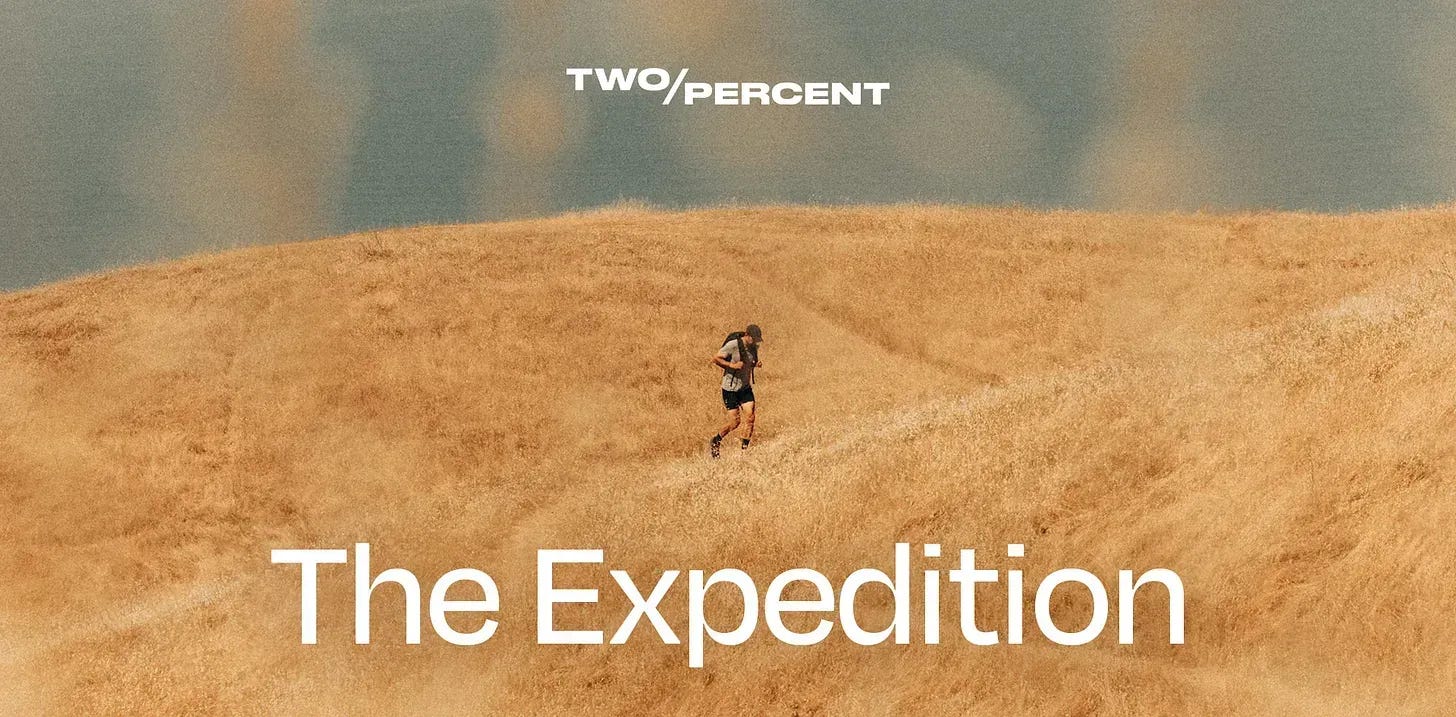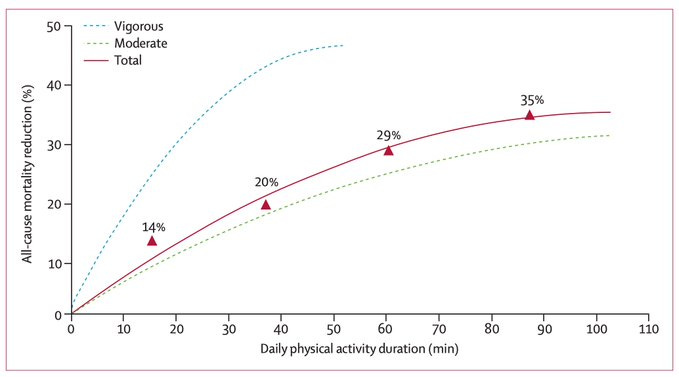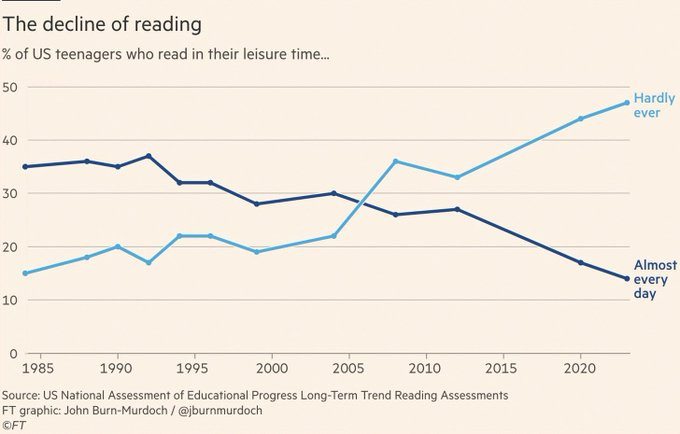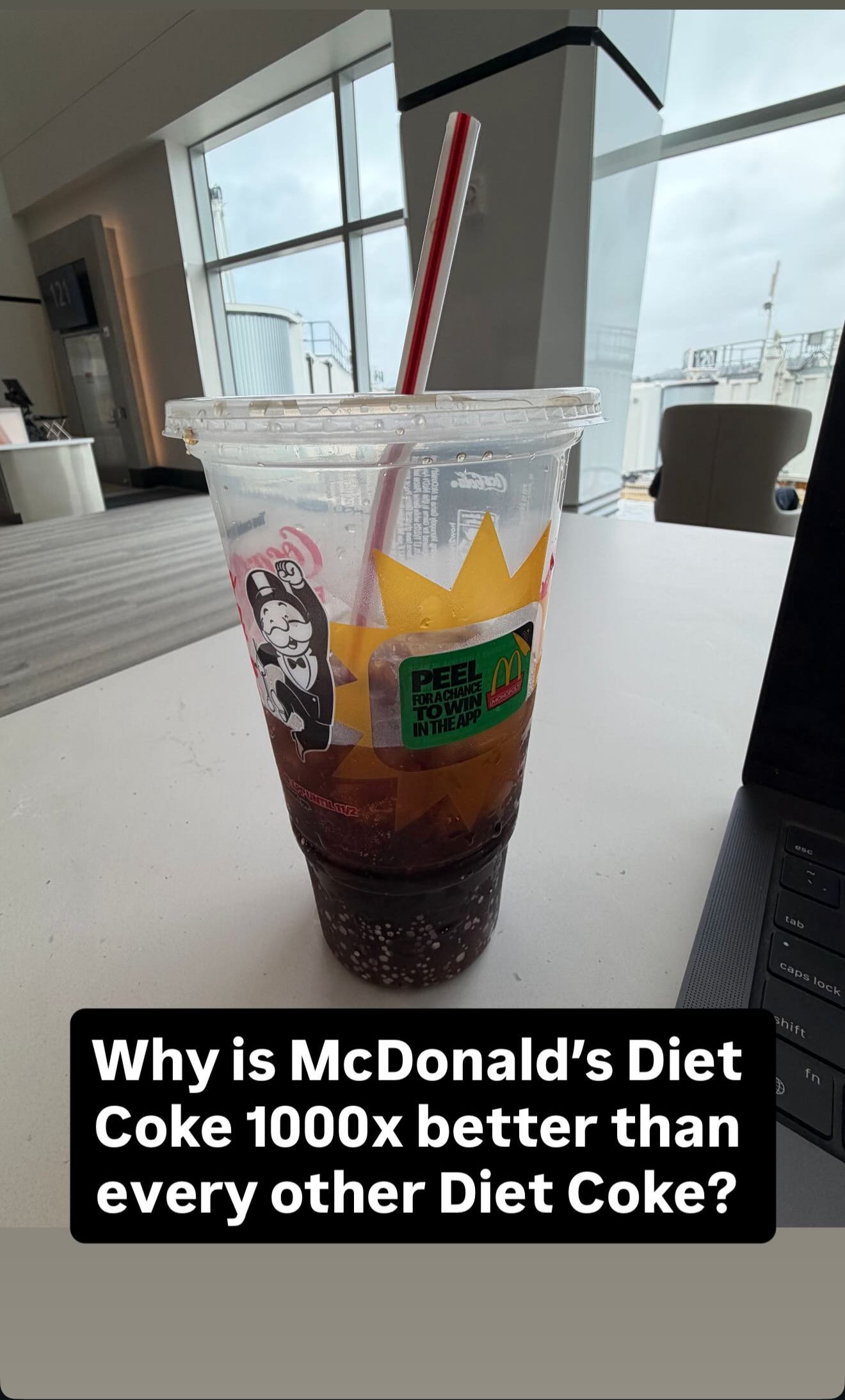A rucking warning, protein powder contamination, diet soda, and more
The Expedition: 17 ideas to improve your life this month.
The Expedition is our monthly journey into thoughts, opinions, ideas, observations, studies, facts, figures, etc.
Good ones, insightful ones, interesting ones, weird ones, and ones you can use to live well and long.
It’s a roundup of all the worthwhile stuff I’ve discovered in the last month. The Expedition is a bit of an island of misfit toys. But, hey, the greatest journeys are winding.
Quick housekeeping:
If you want full access to this post and all future and past Two Percent posts—plus audio versions—please become a Member here:
Shoutout to our partners:
Function Health offers 5x deeper insights into your health than typical bloodwork. They’re offering a $100 discount right now. Head to my landing page functionhealth.com/michaeleaster to sign up with your credit applied.
Momentous made me feel good about supplements again. They’re trusted by pro sports teams, the U.S. military—and Two Percent. Their Fuel hydration powder is a lifesaver on long runs. Use discount code EASTER for 35% off.
This month’s Expedition covers:
Numbers on:
Plant protein and lead contamination.
Ideal minutes of daily exercise.
Water and hunger.
An easy way to support songwriters.
Health impacts of GMO foods.
Why naked mole rats live so long.
Teens and reading.
A long workout.
The oldest Golden Retriever.
Why McDonald’s Diet Coke tastes 1000x better than all other Diet Cokes.
Does social media impact learning?
The truth about light and sleep.
Why your blood pressure is high, illustrated.
The most efficient form of travel.
A warning about the rise of rucking.
Tell me a fiction book you loved.
A parting quote.
Let’s roll …
By the numbers
2/3rds …
… of 23 different protein powders tested contained high levels of lead based on Prop 65. Some of those powders contained 10x the Prop 65 threshold.
Plant protein powders generally contained the most lead. The biggest offenders were from Naked Nutrition and Huel. But even my go-to, Momentous, which is NSF-certified, failed by Consumer Reports’ standards.
The good news: Fear not. Adam Bornstein at Arnold’s Pump Club wrote a great section that explained some flaws in Consumer Reports analysis and put questions about lead in context. For example:
Consumer Reports used Prop 65, a legal warning threshold, not a scientific safety level. It’s far lower than the health benchmarks set by the FDA, WHO, and EU.
Most plants have lead (they naturally take it up from soil). For example, Momentous’ plant protein (which I use daily) has the same range of lead you’d find in a standard serving of fruits and vegetables.
That said, if you’re still freaked out, just use a whey protein. Cows effectively “filter out” the lead found in the plants they eat.
90
Minutes of moderate daily exercise that led to the largest reduction in all-cause mortality (35%).
If that’s too time-intensive—and it is for most people—even 15 minutes gave participants a 14 percent reduced risk of all-cause mortality.
500
Milliliters of water (about 16oz), 30 minutes before a meal, led people to eat 74 fewer calories.
2-3X
Times more money Apple Music pays songwriters per stream than Spotify. Because of this, all playlists on Two Percent will now be Apple Music playlists
Use Apple Music. Keep songwriting alive.
Source: A songwriter friend with hundreds of millions of streams.
5 to 17
Percent increase in VO2 max from doing two or more daily “exercise snacks,” brief bouts of movement. Note that the study was conducted in an older, mostly sedentary population. If you already exercise, you likely wouldn’t see as big a benefit.
0
Adverse health impacts of eating GMO food. The study was conducted over roughly 7 years and involved primates. The animals and their offspring ate either genetically modified food or non genetically modified food. There were no significant differences in health outcomes between the two groups.
4
Genetic mutations in naked mole rats give them the longest healthspan and lifespan of any rodent (~40 years). These mutations promote DNA repair and suppress inflammation.
This new finding may have implications for scientists studying human longevity.
15
Percent of US teenagers read for leisure nearly every day today. In 1985, that figure was 35 percent.
During that same period, the number of teens who hardly ever read for fun increased from 15 percent to nearly 50 percent.
89
Hours straight that ultrarunner Olivia Amber spent climbing California’s highest peaks to set a speed record.
20
The age of August, the oldest Golden Retriever in the world. Let’s all wish August a happy 20th. Just one more year and you’ll be able to drink, buddy.
The Mystique of McDonald’s Diet Coke
I was recently at the San Diego airport, where I got a fountain Diet Coke from McDonald’s and posted a photo of it to my Instagram stories, accompanied by a simple question.
This set off a torrent of responses, some sensical (“McDonald’s filters their water”), others not so much (“a conspiratorial relationship between McDonald’s and Coke”).
Two Percent is all about asking and getting to the bottom of life’s most essential questions. So, naturally, I started digging. Here’s what I found—Ronald McDonald’s six-step playbook for the most consistently glorious Diet Coke known to humankind.
Step one: Get the best syrup
McDonald’s and Coca-Cola began working together back in the 1950s. They inked a deal where McDonald’s gets a proprietary delivery method for soda syrup (ok, so maybe that conspiracy thing was sort of correct).
Their syrup doesn’t get shipped in plastic bags, like everyone else’s does. It gets shipped cold in stainless steel tanks, which helps keep the syrup flavor fresh, strong, and bright.
Step two: Chill the syrup
At most soda fountains, the soda syrup bag is typically attached near the machine and often stored at room temperature.
But McDonald’s stores the steel soda syrup tanks in their refrigerators. The lines that run from the fridge to the fountain are all insulated to maintain lower temperatures.
This keeps the syrup’s flavor more intact, and the drink stays colder, enhancing the flavor.
Step three: Mix with cold, clean, overly-carbonated water
Most restaurants don’t filter the municipal water, which is then carbonated and mixed with the soda syrup to produce the drink.
McDonald’s filters the hell out of all the water used in their soda fountains. This removes flavor impurities, makes the drinks taste similar across locations, and lets that nectar-of-the-Gods Diet Coke flavor sing.
They also over-carbonate the water and ensure that it’s cold, which makes the drink extra bubbly and boosts the flavor. This leverages a principle called “Henry’s Law.” Simplified: Colder liquid allows carbon dioxide to dissolve while maintaining its gaseous state, resulting in a better-tasting drink. Nerds, deep dive here.
Step four: Obsess over the ratios
At this point in our Diet Coke saga, we’ve got better syrup and better carbonated water. But if you don’t mix those two correctly, all hope dies.
At most fountain soda machines, you have a methed out gas station attendant or an underslept high school worker setting the syrup-to-carbonated water ratios to what seems right.
McDonald’s doesn’t leave the water-to-syrup ratio open to interpretation. It’s tightly controlled for consistency across restaurants. They also err on the side of having a bit more syrup than other chains, knowing that as the drink’s ice melts it will dilute the soda.
Step five: Engineer the perfect soda delivery vehicle
McDonald’s straws are wider than most.
They’ve rested and retested the circumference of straws and found that the slightly wider straw enhances the flavor and allows more of the carbonation to dance on your tongue.
Step six: Keep it clean
If you’ve ever worked at a bar, you’re probably aware that bad tap lines make beer taste off.
The same goes for soda. McDonald’s obsessively cleans the lines that feed the water and syrup into their soda, keeping the flavor pure.
That’s it. That’s why McDonald’s Diet Coke is soda as a religious experience. Thank God I paid so much money to go to grad school to study science journalism, so I could investigate rich and profoundly important topics like this.
From here you’ll learn:
-Social media and learning (important for parents).
-The truth about blue light and sleep (good sleep advice).
-The number one killer and how to get good personal data to avoid it.
-Fascinating information about cycling.
-A warning about the rise of rucking.
-Book recommendations.
-Wonderful exercise advice.





